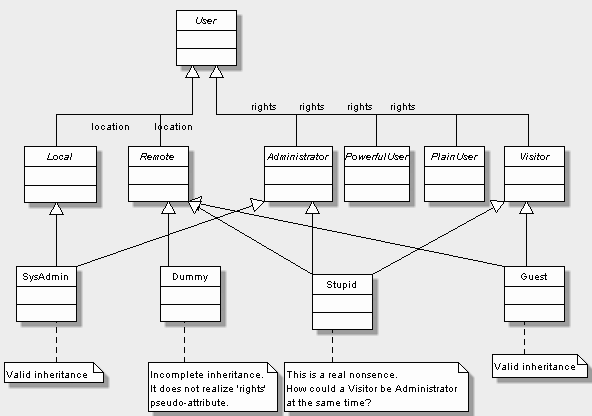Generalization is a relationship between two use cases or two actors. Where A is a generalization of B, it means A describes more general behavior and B a more specific version of that behavior.
Examples for a travel agent sales system might be the use case for making a booking as a generalization of the use case for making a flight booking and a salesman actor being a generalization of a supervisor actor (since supervisors can also act as salesmen, but not vice versa).
Generalization is analogous to class inheritance within OO programming.
![[Note]](images/note.png) | Note |
|---|---|
It is easy to confuse extends relationships between use cases with generalization. However extends is about augmenting a use case's behavior at a specific point. Generalization is about specializing the behavior throughout the use case. |
Within the UML metamodel,
Generalization is a sub-class of
Relationship.
Generalization is represented as an arrow with white filled head from the specialized use case or actor to the generalized use case or actor (see Figure 17.1, “ Typical model elements on a use case diagram. ”).
The details tabs that are active for associations are as follows.
ToDoItemStandard tab.
PropertiesSee Section 17.8.2, “ Generalization Property Toolbar ” and Section 17.8.3, “ Property Fields For Generalization ” below.
DocumentationStandard tab. See Section 13.4, “ Documentation Tab ”.
PresentationStandard tab.
![[Note]](images/note.png)
Note The values in the "bounds" field of the generalization are not editable, since they are determined by the properties of the endpoints of the line.
StereotypeStandard tab.
Tagged ValuesStandard tab. In the UML metamodel,
Generalizationhas the following standard tagged values defined.derived(from the superclass,ModelElement). Valuestrue, meaning the generalization is redundant -it can be formally derived from other elements, orfalsemeaning it cannot.![[Note]](images/note.png)
Note Derived generalizations still have their value in analysis to introduce useful names or concepts, and in design to avoid re-computation.

Go upNavigate up through the package structure of the model. For a generalization this will be the package containing the generalization.

New StereotypeThis creates a new Stereotype (see Section 16.6, “ Stereotype ”) for the selected generalization, navigating immediately to the properties tab for that generalization.

DeleteThis deletes the selected generalization from the model.
![[Warning]](images/warning.png)
Warning This is a deletion from the model not just the diagram. To delete a generalization from the diagram, but keep it within the model, use the main menu
Remove From Diagram(or press the Delete key).
NameText box. The name of the generalization.
Textfeld. Der Name der Generalisierung.
![[Tip]](images/tip.png)
Tip It is quite common to leave generalizations unnamed in use case analysis.
![[Note]](images/note.png)
Note ArgoUML does not enforce any naming convention for associations.
![[Note]](images/note.png)
Note There is no representation of the name of a generalization on the diagram.
Discriminator,DiskriminatorText box. The name of a discriminator for the specialization. UML 1.4 allows grouping of specializations into a number of sets, on the basis of this value.
![[Tip]](images/tip.png)
Tip The empty string “” is a valid entry (and the default) for this field. The discriminator is only of practical use in cases of multiple inheritance. A (class diagram) example is shown in Figure 17.2, “ Example use of a discriminator with generalization ”. Here each type of user should inherit from two sorts of user. One distinguishing between local or remote user (which can be identified by one discriminator) and one indicating their function as a user (identified by a different discriminator).
There is little point in using this within a use case diagram.
NamespaceText box with navigation button. Records the namespace for the generalization. This is the package hierarchy.
ParentText box. Shows the use case or actor that is the parent in this relationship, i.e. the more general end of the relationship. Button 1 Double Click on this entry will navigate to that use case or actor.
ChildText box. Shows the use case or actor that is the child in this relationship, i.e. the more specific end of the relationship. Button 1 Double Click on this entry will navigate to that use case or actor.
PowertypeDrop down selector providing access to all standard UML types provided by ArgoUML and all new classes created within the current model.
This is the type of the child entity of the generalization.
![[Tip]](images/tip.png)
Tip This can be ignored for use case analysis. The only sensible value to put in would be the child use case type (as a classifier, this appears in the drop down list.
